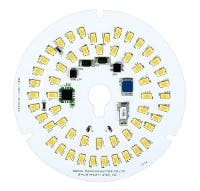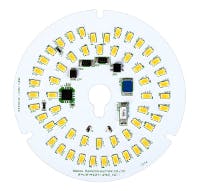Seoul Semiconductor has announced new versions of its Acrich2 modular LED light engines that have upped efficacy over prior designs by 20% to 140 lm/W. The new AC-LED modules integrate LEDs in concentric circular patterns on a circuit board designed to produce a light pattern ideal for surface-mount solid-state lighting (SSL) ceiling fixtures for living rooms, kitchens, and porches.
Seoul said that the efficacy of the new modules matches the best DC-driven LED modules on the market. The company said that the 140-lm/W efficacy is equivalent to the system efficacy that can be achieved with 180 lm/W DC LEDs. That comparison implies the fact that the AC driver is included on the Seoul module whereas the DC LEDs would require a driver with some inherent losses.
"Efficiency and design flexibility have been dramatically improved with the latest Acrich2 modules giving 140 lm/W," said Marten Willemsen, vice president of marketing for Seoul Semiconductor. "Acrich2 modules have already been adopted by well-known lighting manufacturers and are selling in major retail stores. We believe the success of the Acrich2 LED modules will increase our market share in both the indoor and outdoor LED lighting markets."
The newest 10W modules deliver 1400 lm in cool white or 1250 lm in warm white. Seoul offers the products in both 120V and 220V models to support markets around the globe.
We recently covered some discussions on AC-LED technology relative to traditional DC LEDs that took place at The LED Show a few weeks back in Las Vegas. In that article, Paul Scheidt, product marketing manager at Cree, essentially said that AC LEDs couldn't match the efficacy of DC-LED-based systems because of utilization level. In an AC-drive system some of the LEDs are off at all times and Scheidt said the best implementations achieve 70% utilization.
Seoul didn't address utilization level in their new announcement. But efficacy at the system level ultimately is what matters. The latest efficacy specs put Acrich2 in the same class as DC LEDs, although some questions will remain on issues such as flicker and EMI that were also covered in The LED Show article. Of course, the big advantages of AC LEDs are a simpler driver, smaller footprint, and lower cost.






